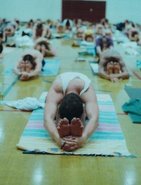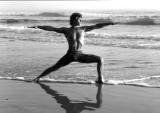An occurrence of extreme rarity is in the offing. I get to do a mysore type practice two days in a row. I have no recollection of when that last occurred. I doubt it's happened more than 3 or 4 times in the 3 years I've been doing yoga. I got to go this morning because I was scheduled for an "off" day for some reason. Tomorrow I'm post-call. Normally, I'd miss out on a mysore class because they are from 7 to 9 on Wednesdays. The glut of students during the teacher training has led to our teacher allowing some students to do an overflow practice at 9:00 to minimize the crowding in the normally scheduled classes. I asked if I could join them tomorrow and was given the green light. I doubt there will be any adjustment from Tim or his normal assistants. That's when they normally do their practice. The teacher trainees have started to do adjustments in classes, so maybe some of them will be adjusting during that practice time.
I went to pranayama this morning. Tim added in the other two types of breathing that we normally do: bhastrika, or bellows breathing, and sitali, or cooling breath. I like both of them. They kind of wind down the session. After completing the alternate nostril breathing with retention, the hard part of pranayama is over, unless you want to count the knees getting sore and the legs going numb from sitting in lotus for 45 minutes. In the bhastrika breathing, after a long inhale, you hang on to your feet and forcefully and quickly breath in and out thru the nostrils 50 to 100 times in about a minute. The breaths are fairly shallow, the exhales being something like a short snort. As you get to the last few breaths, you more completely empty the lungs until with the last one you squeeze out every last iota of air. Then you make a long inhale and then a long retention. When I count during this retention, I normally get to somewhere around 35-40. Today we released at around 20-25. We do three repetitions. Then, after three ujjayi breaths, we do three breaths where the inhale is made thru a rolled tongue, the sitali breath. It really is strikingly cooling.
After pranayama, there was a led first series class with Tim at 7AM. I decided to hang out and watch since my Mysore class was going to follow right after the led class. It is interesting to actually just watch a full class from start to end. It's not something we ever really get to do very much. About the only other time I can think of doing that was when Guruji was here on his trip. You get to see such a wide array of approaches to doing the first series postures. The hardest part is that there's too many people to watch. I ended up just mainly watching the guys in the group. There were three or four teacher trainees circulating the room adjusting. I chuckled a bit when one of them adjusted Tim in down dog. He didn't adjust him really, just gave the usual push on the low back/sacral area. While perfectly reasonable, and probably desired (who doesn't like that extra pressure down into the heels?), it just seemed semi-sacrilegious at first glance. One advantage of watching like that is that you get to see things that would be blocked from view if you were doing the class yourself. I watched closely during supta kurmasana. First, not that many people got into it and second, of the ones who did, a fair proportion of them sat up and crossed their feet behind their heads then laid back down and bound their hands. I was surprised to see that few people bound their wrists in pindasana. You can catch a lot of little things that probably don't really add up to much really. It's just a different perspective
For my practice, I set up in a different place than I typically do. I wanted to be near enough one of the people I had seen adjusting to get a sense of what their practice was like. I ended up being in a mini-chorus line of guys. The others all ended up doing 2nd series while I did my usual first and smattering of early second poses. Tim must have told the trainees to mainly adjust each other because it seemed like they left the "regulars" to Tim and his usual assistant. Not one of them came by me. My only adjustments today were in parivrrta trikonasana and kapotasana. By the time I finished laghuvajrasana and did what kapotasana research poses I had time for, today mainly the viparita dandasana sequence Tim does in his Intro to 2nd series and his Improv classes, I could tell I was not at the level where I was likely to have a record breaking effort. As I dropped back and set up my foundation, Tim's assistant stepped in and helped me get a lot deeper than I was going to be able to do on my own. Deep enough that I let out one of those inadvertent grunts of concern when he pulled my hands back on my feet. In this posture, my shoulders are probably my biggest barrier to progression. I don't know if it was all those years of mis-hitting balls when I played volleyball or what, but I have trouble rotating my arms and hands back like they need to be in kapotasana. When I'm helped out, they can be put in the right place, but my shoulders usually let me know they don't appreciate it. After coming out of the posture and letting the blinking lights fade out, Tim walked up and commented to his assistant, "You know, He's kind of a 'two-person' job. Let's try it again." So I did it again with both of them. I ended up as deep as I have ever been, which is not that deep but it feels like it is. One of the best feeling adjustments you can get is the two person kapotasana adjustment. One person will be at one end bracing your knees with their toes while they pull back on the hips to stretch the groin. The other person is at your front end, with their toes ensuring your elbows are down to the ground while they grasp you around your shoulder blades and externally rotating them while stretching your body forward, opposing the force being applied at the other end. You would think being pulled in opposite direction like that while in an already intense posture would be too much but the opposite is true. The pull relieves all the pressure and gives a really good stretch to the spine.
When I was doing my backbends after kapotasana, I didn't feel all that great. I've certainly been able to get into the poses much better than I did today. After I did the first few backbends, I found I was able to get my weight moving toward my feet better than I ever had before. I wanted to see if i could get my hands up off of the ground. On my last try, I moved a little closer to the wall so that I could hopefully transition to it if I got my hands up. It turns out I got half way up to standing. I still wasn't anywhere close to the weight shift necessary to pull off the full stand up. Part way up I realized this. To avoid a rapid re-entry onto my mat, I twisted and fell back toward the wall in a nearly almost standing/semi-falling down position. There was probably a noticeable impact, since I glanced over to see if my wife had caught my 'performance' and several people were looking to see what had happened. My wife laughed out loud at me again. Bad move on her part. Later in her practice, when doing her viparita chakrasana sequence, she blew it badly and semi-cratered, nearly pulling Tim down with her. Karma chameleon. Who knows. Maybe a few more times and I'll accidentally get up. The problem then will be repeating it. Also, once I ever do get up, then I have to figure out how to get back down. That is one big fear for me, I have to admit. I just have visions of smashing face first into the mat and getting a cervical spine injury. This is one of those cases where having some medical knowledge definitely works against me.
Tuesday, June 24, 2003
Subscribe to:
Post Comments (Atom)


No comments:
Post a Comment